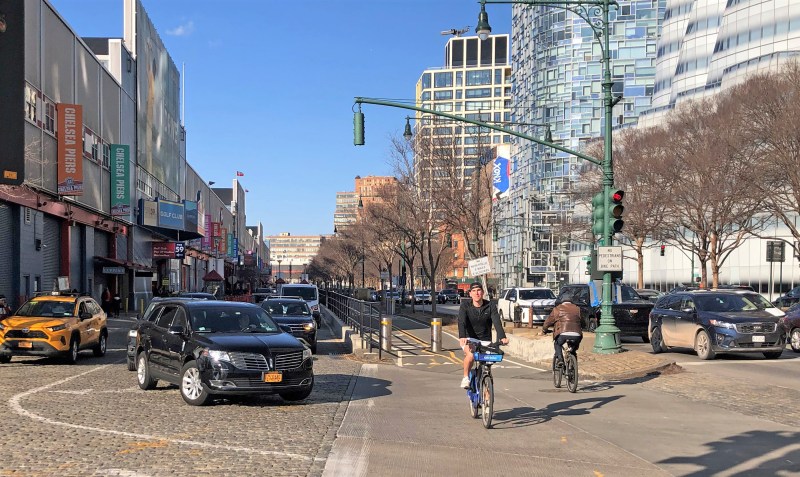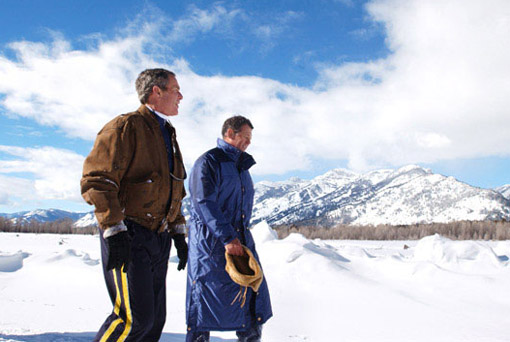CHELSEA FEARS: Locals Want More Space for Bikes at Waterfront Rec Center

The lease — and maybe the jig — is up.
As the Chelsea Piers facility seeks a new lease [PDF], Manhattan’s super-progressive Community Board 4 is poised to demand that the entertainment and sports complex reduce the width of its driveway to create a safer Hudson River Greenway at one of its notorious pinch points. It’s a demand that has been on Westsiders’ agenda for decades, ever since the piers were converted to recreation and commercial space in the mid-1990s and a wide sidewalk narrowed to make room for cars and trucks.
“The service road today is still 27 feet wide, while the sidewalk is a mere eight feet,” a draft letter from the CB4 Waterfront Committee to the Hudson River Park Trust and Chelsea Piers complains. “Conflict between cyclists and pedestrians are near-constant in this area, and pedestrian safety is further jeopardized by the movement of vehicles, including large production trucks and buses.

“Prioritizing access for vehicles in parks is not appropriate,” continues the letter, which will likely be passed by the full board at its meeting on Wednesday, March 2. “Manhattan CB4’s greatest objection to the new lease is the failure to require the removal of the vehicle parking lane east side of the facility. Eliminating the lane will increase pedestrian access to the piers, expand the sidewalk, and improve pedestrian movement on the upland side of the piers, which right now is narrow, confusing and forces pedestrians onto the roadway or greenway.
“Given the demand for better traffic and vehicle management across the city, improving of the environment, and the need to create more safe space for pedestrian passage, the fact that no improvement is being made to the traffic lanes on Park property is unacceptable,” the letter concludes.
It’s not as if the driveway could not be easily narrowed to create more pedestrian space and widen the bike path at one of its narrowest points. Currently, one of the three lanes is often to store vehicles or for parking anyway.
“Both of those activities should take place inside the piers, not in the public realm,” the letter states. “Given their interior vehicle facilities, it is alarming that Chelsea Piers would be allowed to continue its current outside operations given how much the city and area around it has changed since 1996.”
The committee’s concern about pedestrian and cyclist safety at the 28-acre waterfront sports and party village is not likely to alter the negotiations over the new lease, as there is a lot more at stake. For example, the new lease would charge Chelsea Piers roughly $4 million a year in rent in exchange for allowing the facility to continue serving thousands of athletes (weekend and otherwise), host events, housing film crews (full disclosure: this reporter plays a laughable version of ice hockey there every Sunday). Chelsea Piers will continue to maintain the basic infrastructure of the piers that give the center its name (a not-inexpensive job, which is part of the reason that Chelsea Piers wants a new lease so it can refinance its mortgage).
But given the magnitude of the main issues, what the CB4 committee is seeking amounts to an extremely minor change that would mean a lot to cyclists and walkers.
“They say they have an engineering report that says they can’t narrow the roadway, but the road was not in their initial lease — and I know because I negotiated that lease,” said Tom Fox, who was head of the Hudson River Park Conservancy when Chelsea Piers got its first lease (he was later fired by Gov. Pataki in a move that stunk of politics and quid-pro-quo with GOP fundraiser Roland Betts, who remains in charge of the complex). “There was one lane there, but then they narrowed the pedestrian path to a sidewalk that crosses all their driveways. The bicycle lane was made smaller. And the lane exiting Chelsea Piers is wide. None of that was in the original plan.”
Fox echoed CB4’s letter in acknowledging that Chelsea Piers is an outstanding neighborhood resource that creates jobs and lots of activities for thousands of people. But he supports CB4’s letter, arguing that Chelsea Piers has “exploited the opportunity.”
“Many people in that original fight have died, but I’m still alive,” said Fox. “At the time, we were all blown away by the arrogance. But the last time, the least was with the state DOT. Now it’s with the Hudson River Park Trust, so maybe we have some leverage. The Trust must maximize public safety and the way to do that is to widen the pedestrian and bike paths.”
The draft CB4 committee letter admits that a recent sit-down between members of the board and Hudson River Park Trust President Noreen Doyle and David Tewksbury of Chelsea Piers “was, at moments, heated,” but that’s certainly part of the history of Chelsea Piers and its neighbors. A 1996 article in the Chelsea-Clinton News detailed the negotiations over the original lease — the one that led the proposed bike path to be narrowed by nearly one-and-a-half feet to accommodate the three-lane roadway in front of the piers complex — and the coverage shows that local lions were not pleased.
“It’s clear that we’ve been had,” then-community board member Ross Graham told Tewksbury, the paper reported. (Graham died last year.)
Fellow board legend Ed Kirkland, who died earlier this year, blamed then-Gov. Pataki for fealty to commercial interests inside Hudson River Park (and huge GOP donors).

Streetsblog started covering repeated conflicts between vehicles going to and from Chelsea Piers in 2006, the same year that a drunk driver leaving a Chelsea Piers party drove onto the Hudson River Greenway instead of the West Side Highway, killing a cyclist in the process. Also that year, Dr. Carl Nacht was killed by a tow truck driver as he cut across the bike path and did not yield. More car-pedestrian-bike conflicts have been added to the greenway since, as the waterfront has become more commercialized. A bus driver seriously injured a cyclist in 2014 near the ferry and marina complex at West 40th Street. And a driver drove down the Greenway in 2015, too.
Neither Doyle nor Tewksbury initially responded to a request for comment.
But on Tuesday, a day after this story was initially published, the Hudson River Park Trust sent over the following statement:
Chelsea Piers is an existing Park tenant, with 21 years remaining on its original state lease, and very few controls related to important Park and community issues like access and usage. Renegotiating the lease terms now rather than waiting for the current term to expire presents many potential benefits. The draft lease currently under public review includes new protections and improvements for the Park, such as an expanded pedestrian waterfront access way. Hudson River Park Trust greatly values our long-standing partnership with CB4, and we look forward to continuing to hear from the community on this topic, and many others, throughout the public review and comment period and beyond, as we work towards our shared goal of an ever better Hudson River Park.
Betts has been far less active in making campaign contributions than he was in the salad days of the Bush years, when his friend George W. became president.
Since his first $1,000 contribution in 1999 to help elect George W. Bush, Betts gave more than $100,000 to Republican causes through 2006. Then he started raiding his couch cushions for Democrats, sending $4,600 to then-Senator Barack Obama’s 2008 campaign and $1,000 to Senator Amy Klobuchar in 2012.
He also contributed $400 to conservative Democrat Ray McGuire’s campaign for mayor last year.
Here is a file picture of Betts and George W. Bush that is in Streetsblog’s archives.

The public comment period on the lease runs through April 26 at 4 p.m. To comment, send an email to chelseapierslease@hrpt.ny.gov or a regular letter to the Hudson River Park Trust, Pier 40, 353 West St., Room 201, New York, NY 10014, Attn. Robert Nguyen. A public hearing will be held on March 22, 2022 from 4:30-6:30 p.m. (details to come).